Hitler Youth
Kurt Gruber formed the first group of young members of the National Socialist German Workers Party (NSDAP) in 1926. Rudolf Hess suggested the name of the Hitler Youth (Hitler Jugend) and later that year transferred the leadership of the movement to Franz Pfeffer von Salomon of the Sturm Abteilung (SA). Pfeffer's main intention was to train young men to fight against members of left-wing youth groups. (1)
The Hitler Youth organisation was taken over by Ernst Röhm in 1930 and remained as a adjunct to the SA. After Röhm was murdered during the Night of the Long Knives the group came under the control of Baldur von Schirach, the Reich youth leader. In this post he had proved himself to be a master organizer. For example, he directed a massive youth demonstration in Potsdam, at which more than 100,000 youngsters marched past the Führer for seven hours. (2)
Schirach asked Adolf Hitler for permission to create an independent youth movement. Hitler agreed and Schirach now made several important changes to the way the Hitler Youth was organized. His main objective was to re-educate German youth in the spirit of National Socialism. As Louis L. Snyder has pointed out: "Von Schirach would permit no opposition to his plans. As early as February 1933 he had led a surprise raid of fifty boys on the office of the rival Central Committee of Youth Organizations and confiscated its records." (3)
Cate Haste, the author of Nazi Women (2001) has argued: "The leadership immediately set about organizing youth into a coherent body of loyal supporters. Under Baldur von Schirach, himself only twenty-five at the time, the organization was to net all young people from ages ten to eighteen to be schooled in Nazi ideology and trained to be the future valuable members of the Reich. From the start, the Nazis pitched their appeal as the party of youth, building a New Germany.... Hitler intended to inspire youth with a mission, appealing to their idealism and hope." (4)
Hitler and the Hitler Youth
In 1933 Hitler took power in Germany. At the time the Hitler Youth only had 107,000 members. Non-Nazi youth organizations were far more popular. Hitler solved this problem by dissolving almost all the rival organizations (only Catholic youth organizations survived this measure). All boys and girls in Nazi Germany came under great pressure to join the Hitler Youth. By the end of 1933 there were 2.3 million boys and girls between the ages of ten and eighteen in the Hitler Youth organization. (5)
At the 1934 Nuremberg Rally, described as the Rally of Youth, Hitler told Germany's young people: "Regardless of what we create and do, we shall pass away, but in Germany you will live on. And I know it cannot be otherwise for you are the flesh of our flesh, blood of our blood, and your young minds are filled with the same will that dominates us... And when the great columns of our movement march through Germany today, I know that you will join these columns. And we know that Germany is before us, within us and behind us." (6)
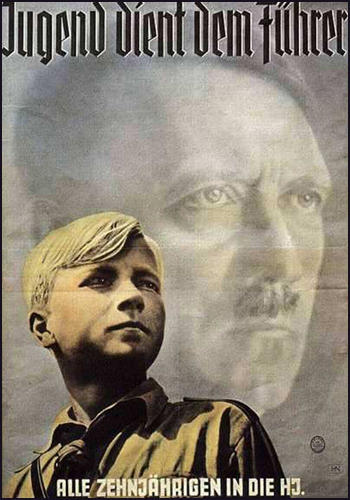
Herman Rauschning claimed Hitler told him: "In my great educative work I am beginning with the young. We older ones are used up. Yes, we are old already. We are rotten to the marrow. We have no unrestrained instincts left. We are cowardly and sentimental. We are bearing the burden of a humiliating past, and have in our blood the dull recollection of serfdom and servility. But my magnificent youngsters! Are there finer ones anywhere in the world?... Youth must be all those things. It must be indifferent to pain. There must be no weakness or tenderness in it. I want to see once more in its eyes the gleam of pride and independence of the beast of prey. Strong and handsome must my young men be. I will have them fully trained in all physical exercises. I intend to have an athletic youth - that is the first and the chief thing. In this way I shall eradicate the thousands of years of human domestication. Then I shall have in front of me the pure and noble natural material. With that I can create the new order." (7)
Hitler proclaimed at the 1935 Nuremberg Rally: "In our eyes the German boy of the future must be slender and supple, swift as greyhounds, tough as leather and hard as Krupp steel. We must bring up a new type of human being, men and girls who are disciplined and healthy to the core. We have undertaken to give the German people an education that begins already in youth and will never come to an end... Nobody will be able to say that he has a time in which he is left entirely alone to himself." (8)
Members of the Hitler Youth had to learn this speech by heart. Herbert Lutz joined the Hitler Youth when he was seven-years-old. His father was a Nazi Party official in Cologne: "My parents moved into a modern housing project in the suburb of Zollstock, where, at the age of seven, I joined the Hitler Youth... He (Hitler) was admired, very much admired. We all really loved him. We felt he could do no wrong." Lutz goes on to argue that he was so idolized that when he was eight-years-old he asked himself, "What happens if he dies? He does everything." (9)
It was through the youth organisations that Hitler sought to build the new Germans for the future. "Look at these young men and boys! What material! With them I can make a new world.... My teaching is hard. Weakness has to be knocked out of them. In my Ordensburgen a youth will grow up before which the world will shrink back. A violently active dominating, intrepid, brutal youth - that is what I am after." (10)
The authors of What We Knew: Terror, Mass Murder and Everyday Life in Nazi Germany (2005) carried out a detailed survey into life in Nazi Germany. They found that young people were much more likely to be supporters of Adolf Hitler than adult Germans: "This... probably reflects the Nazis' strong efforts to mold the new generation for the benefit of the regime after its seizure of power, through direct and indirect influence, such as through schools and the Hitler Youth... Young people are characteristically less committed to previous conditioning than older people; they can be easily molded. (11)
Erwin Hammel pointed out; "As children, we didn't have the opportunity to travel, so we didn't get to know Germany from another point of view. We didn't have that at all. This made the propaganda that we were exposed to seem very plausible. We heard and saw nothing else. People today can't imagine this at all... We didn't have the opportunity to hear about the world abroad. There were no foreign newspapers, and so on." (12)
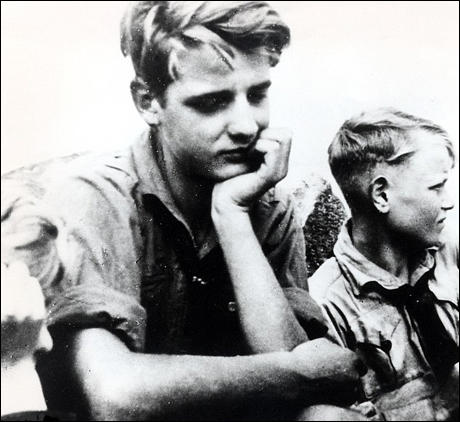
In July 1936 the Hitler Youth had total control on the provision of sports facilities for all children below the age of fourteen. Soon afterwards, sports for 14-18 year-olds were subjected to the same monopoly. In effect, sports facilities were no longer available to non-members. On 1st December, 1936, the Hitler Youth was made a state agency. Now, every young person was expected to belong to the Hitler Youth. (13) The Hitler Youth now had 5 million members and was by 1937 the largest youth organisation in the world. (14)
Bert Trautmann was highly valued by the Hitler Youth as he combined great sporting talent and Aryan looks: "The newspapers and cinemas were soon full of it (the Hitler Youth)... idealised images of blond young athletes in white vests and flannels, shot-putting, hurdling, running, javelin throwing, swinging on the parallel bars; whole fields of them putting on a display of gymnastics at some Nazi rally, row upon row of perfect Aryan specimens, muscles taut, eyes blank, all facing the Führer standing on a distant podium festooned with laurel leaves and swastikas, flanked by Himmler, Göring, Goebbels and the rest." (15) In June 1934 Trautmann was only one of two boys in Bremen to be presented with a certificate of achievement, signed by President Paul von Hindenberg, for his "unsurpassed level of athletic ability." (16)
Children could not attend school unless they were members of the Hitler Youth. However, some parents were successful from stopping their children from attending. Alice Ungerer, the mother of Tomi Ungerer, did not want him to be a member and had a meeting with the local head of the Nazi Party: "In her best High German explained that upper crust people like the Ungerers, the elite of the Reich, had no time wasting their energies with the common rabble, that these people needed an education that she and her family didn't need. Heil Hitler, Ja wohl, dispensation granted." Tomi was disappointed by this decision: "It was with some envy that I watched my school pals in splendid uniforms marching off for fun and sports. These uniforms were all given out for free in Alsace. And what I coveted the most was the Hitler Youth dagger that came with it." (17)
Life in the Hitler Youth
Adam Grolsch has pointed out that before Hitler came to power in 1933, the Hitler Youth was not a popular organisation. He believed that all his teachers disapproved of it. This all changed after he took over the country. "It is rather amazing from today's point of view that Hitler was so strongly supported by the teachers and the German middle class. This was not the case, however, when he was still struggling, not before 1933. They were all against him then. But after 1933, they discovered that he was actually just what the country needed... More than anybody, the teachers immediately did an about face and embraced Nazism. (18)
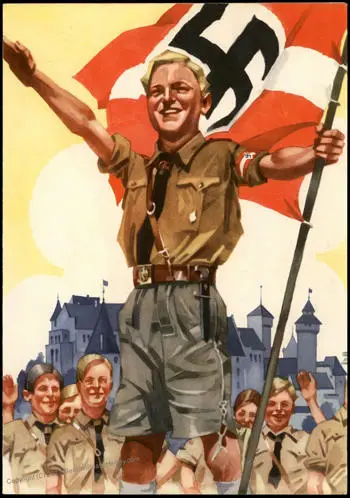
Erich Dressler joined the Jungvolk (for boys aged ten to fourteen) when a branch was started in Steglitz in 1935. "I first heard about this from a schoolfellow who wanted me to join. I was very keen but I did not dare to say anything about it at home, for I knew my father would do all he could to stop me... He used to say the most shocking things about the Führer. So I did not tell him about the Jungvolk, but I joined it all the same - and with it began for me the greatest experience of my life.... We had group meetings with community singing, story-telling and reading. And whatever was read to us was well-chosen. It was invariably picked from German history, and it is only proper, most of it was about the many great soldiers which our nation has produced. (19)
Robert Scholl was a strong opponent of Adolf Hitler and was very upset when his two sons, Hans Scholl and Werner Scholl joined the Hitler Youth and his three daughters, Sophie Scholl, Inge Scholl and Elisabeth Scholl became members of the German League of Girls (BDM) in 1933. Elisabeth later pointed out why they rejected their father's advice: "We just dismissed it: he's too old for this stuff, he doesn't understand. My father had a pacifist conviction and he championed that. That certainly played a role in our education. But we were all excited in the Hitler youth in Ulm, sometimes even with the Nazi leadership." (19a)
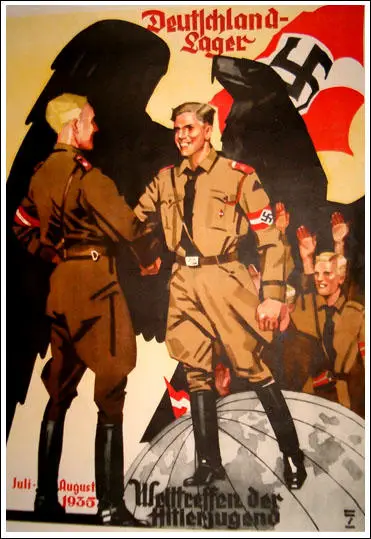
Rolf Heberer joined the Hitler Youth in Freital as soon as he was old enough. His father was a member of the Nazi Party and brought him up to support the government: "Until 1933 there was the period of unemployment. And then Adolf basically got the unemployed off the streets with the measures he took, like building the Autobahn. The people were content. They had a job.... The Hitler Youth were always making trips somewhere. One felt like part of a community. Mostly it was the case that those you went to school with or who were in your class were all involved... the Nazis understood well how to fill people with enthusiasm for certain things." (20)
Paul Briscoe, an English boy was only six-years-old when he first saw the Hitler Youth marching through the streets of Miltenberg: "The first Hitler Youth parade I saw electrified me. Seppl (his mother's boyfriend) lifted me onto his shoulders so I could watch it. Behind fluttering banners, rattling side-drums and blaring bugles, row after row of uniformed boys marched past with jutting chins and jaunty caps. I didn't think of them as boys; to me, they looked like gods. When Seppl told me that one day I might be one of them, I could hardly believe him - it seemed too good to be true." (21)

The boys had to learn semaphore, arms drill, and take part in two-day cross-country hikes. They also had to learn Nazi dogma and once they passed the necessary tests they were given a special dagger marked "Blood and Honour". Anna Rauschning later wrote about the experiences of her own son in her autobiography, No Retreat (1939): "A twelve-mile march was considered a mere nothing for boys who are trained until they can make a march of fifty miles without other food than the concentrated ration they carry in their packs. Nupp (her son) was convalescing from a heavy cold but he was not excused the hike. He had a severe relapse as a consequence. I told our doctor I feared the boy would not be able to do the strenuous tasks required, and he gave me a written statement to the effect that our son must be excused from the more violent features of training. Later the doctor confided to me that often after one of these lengthy marches he had as many as thirty boys in hospital. Pale-faced little fellows sometimes made a march of thirty miles singing Nazi songs through the night, for their graduation ceremony." (22)
If you find this article useful, please feel free to share on websites like Reddit. You can follow John Simkin on Twitter, Google+ & Facebook or subscribe to our monthly newsletter.
Discipline was very strict in the Hitler Youth. Herbert Lutz explained the system of punishments employed in his unit in Cologne. "Whenever you have kids at that age, around ten years, or twelve years and younger, you have to maintain discipline. The discipline in the Hitler Youth was maintained simply by having certain punishments. For instance, if you talked out of turn, you were punished by not being allowed to wear your scarf for three weeks. That was not for really severe crimes; it was for clowning around or whatever. The other punishment was a more severe punishment. Part of our uniform was a dagger. Can you imagine a ten-year-old carrying a dagger? It was an honor to be allowed to wear that. If you did something really nasty, you were not allowed to wear your scarf and your dagger and that meant that you were like an outcast. If something worse happened, they would send you home and you had to work it out with your parents. That worked really well." (23)
Bert Trautmann joined the junior branch of the Hitler Youth on his tenth birthday. "Bert Trautmann couldn't wait to join the Hitler Youth. His mother, better educated than his father, had her misgivings. Her bright boy, her special one, hardly bothered with school books these days. But begged by Bert and bombarded with Nazi propaganda, his parents scraped together the money it took to buy the uniform: short black trousers, khaki shirt, black necktie and leather toggle, plus a badge bearing the Hitler Youth insignia, a flash of lightning on a black background. Bert wore it with intense pride as he stood erect giving the Nazi salute before the swastika banner, hair shorn short back and sides." (24)
Hitler Youth for Girls
The Bund Deutscher Mädel (German Girls' League) was formed as the female branch of the Hitler Youth movement. The duties demanded of the (BDM) included the regular attendance at club premises and camps run by the Nazi Party. Christa Wolf joined the BDM in Landsberg. Her unit used to meet every Wednesday and Saturday. She remembers the importance of singing songs at meetings. This included the following: "Onward, onward, fanfares are joyfully blaring. Onward, onward, youth must be fearless and daring. Germany, your light shines true, even if we die for you." (25)
According to Richard Grunberger the ideal "German Girls' League type exemplified early nineteenth-century notions of what constituted the essence of maidenhood. Girls who infringed the code by perming their hair instead of wearing plaits or the 'Grechen' wreath of braids had it ceremoniously shaved off as punishment. As a negative counter-image Nazi propaganda projected the combative, man-hating suffragettes of other countries." (26)
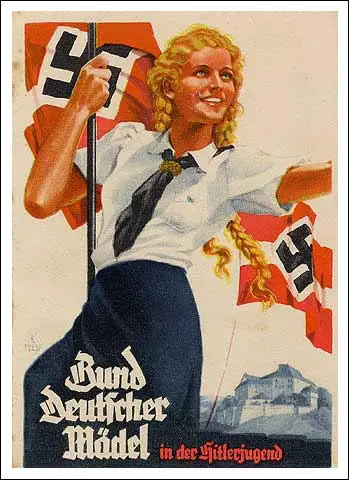
Melita Maschmann joined the League of German Girls on 1st March 1933 in secret because she knew her parents would disapprove. Like the other girls she was ordered to read Mein Kampf but she never finished the book. She argued that the BDM gave her a sense of purpose and belonging. Maschmann admitted that "she devoted herself to it night and day, to the neglect of her schooling and the distress of her parents". (27)
Elsbeth Emmerich was recruited by her school: "In High School, I became a member of the Jungmädel (Young Girls). We were all given the entry forms in class to fill in there and then, and told to take it home for our parents' signature.... I enjoyed being in the Jungmädel. We had to attend classes after school and learn about Adolf Hitler and his achievements. We did community work, singing to soldiers in hospitals and making little presents for them like bookmarks, or poems written out neatly. We also went on hikes and collected leaves and herbs for the war effort." (28)
In 1934, Trude Mohr, a former postal worker, was appointed as the leader of the BDM. In a speech soon after taking control of the organisation she argued: "We need a generation of girls which is healthy in body and mind, sure and decisive, proudly and confidently going forward, one which assumes its place in everyday life with poise and discernment, one free of sentimental and rapturous emotions, and which, for precisely this reason, in sharply defined femininity, would be the comrade of a man, because she does not regard him as some sort of idol but rather as a companion! Such girls will then, by necessity, carry the values of National Socialism into the next generation as the mental bulwark of our people." (29)
Hitler Youth in Britain
Adolf Hitler encouraged British sympathisers to invite the Hitler Youth to visit their schools. Worthing was the first town in the country to elect a Fascist councillor, Charles Bentinck Budd. Worthing was now described as the "Munich of the South". Worthing, also had the largest branch of the British Union of Fascists (BUF) in England. R. G. Martin, the headmaster of Worthing High School for Boys, controversially took a school party to Nazi Germany with their production of Shakespeare's Twelfth Night . On their return, Max Fuller, the head of WHSB's Dramatic Society, reported that in Germany "Hitler is looked upon as the saviour of the country." (30)
The following year Martin invited 15 members of the Hitler Youth to visit Worthing High School for Boys. They arrived in March 1936. The local historian, Freddie Feest, argues: "It has since been well documented that there were ulterior motives for most such visits and that German youth with strong Nazi-influenced motivation were surreptitiously – though with various degrees of success and reliability – collecting information, documents and photographs during their tours that might prove invaluable when the time came for Nazi forces to carry out an invasion of that country." (31)
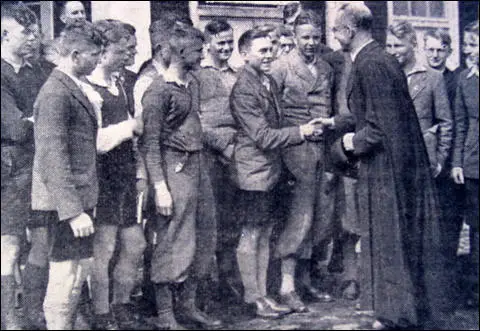
R. G. Martin, the headmaster, later observed that the Hitler Youth boys, "attired in ski caps, open-necked shirts, shorts and stout hiking boots" were a "sturdy lot and far more burly than their English counterparts". The German boys offered to put a show on for the school. "Showing almost military precision, they proceeded to put on a display of gymnastics which Mr. Martin could only describe as stunning, although despite - or perhaps because of - their imposing physiques they lacked, he noted with quiet satisfaction, the suppleness of his boys." (32)
Anti-Semitism & the Hitler Youth
Armin Hertz was a Jewish schoolboy in Berlin. He remembers the children being allowed to sing Hitler Youth songs in the classroom: "The anti-Semitism was very vivid in school... They were trying to teach us Nazi songs. I vividly remember this song they were marching in the street with. The Hitler Youth, young boys actually of our age, were singing, Das Judenblut vom Messer spitzt, geht's uns nochmal so gut. (The Jews' blood spurting from the knife makes us feel especially good). They were also singing it in the school." (33)
Some teachers attempted to provide a balanced view but they were often reported by the children to the authorities. In a lesson that was devoted to those who had been killed in the First World War. The teacher said that some Jewish soldiers in the German Army had lost their lives in the conflict. Straight away one of the boys, who was a member of the Hitler Youth, shouted out. "They had died of fright. The Jews don't have a Fatherland." (34)
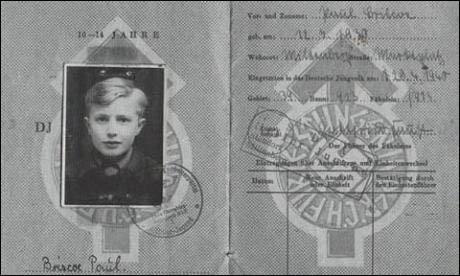
Ruth Mendel, a Jewish girl from Frankfurt, explained how she was attacked by a Hitler Youth boy when she was only a child. "I was run over by a bicycle in 1933 when I was only four years old. I was walking at the edge of the park with my parents and a Hitler Youth boy on a bicycle drove right into me and drove over my knee on purpose of course. He knocked me over, but luckily nothing was broken... My parents didn't say anything... If you went to the police and complained it only meant that you would be beaten up." (35)
A large number of young people took part in what became known as Kristallnacht (Crystal Night). (36) Erich Dressler was a member of the Hitler Youth in Berlin. "Of course, following the rise of our new ideology, international Jewry was boiling, with rage and it was perhaps not surprising that, in November, 1938, one of them took his vengeance on a counsellor of the German Legation in Paris. The consequence of this foul murder was a wave of indignation in Germany. Jewish shops were boycotted and smashed and the synagogues, the cradles of the infamous Jewish doctrines, went up in flames. These measures were by no means as spontaneous as they appeared. On the night the murder was announced in Berlin I was busy at our headquarters. Although it was very late the entire leadership staff were there in assembly, the Bann Leader and about two dozen others, of all ranks.... I had no idea what it was all about, and was thrilled to learn that were to go into action that very night. Dressed in civilian clothes we were to demolish the Jewish shops in our district for which we had a list supplied by the Gau headquarters of the NSKK, who were also in civilian clothes. We were to concentrate on the shops. Cases of serious resistance on the part of the Jews were to be dealt with by the SA men who would also attend to the synagogues." (37)
Paul Briscoe, the son of Norah Briscoe, a member of the National Union of Fascists, had been educated in Nazi Germany and was living in the small town of Miltenberg: "At first, I thought I was dreaming, but then the rhythmic, rumbling roar that had been growing inside my head became too loud to be contained by sleep. I sat up to break its hold, but the noise got louder still. There was something monstrous outside my bedroom window. I was only eight years old, and I was afraid. It was the sound of voices - shouting, ranting, chanting. I couldn't make out the words, but the hatred in the tone was unmistakable. There was also - and this puzzled me - excitement. For all my fear, I was drawn across the room to the window. I made a crack in the curtains and peered out. Below me, the triangular medieval marketplace had been flooded by a sea of heads, and flames were bobbing and floating between the caps and hats. The mob had come to Miltenberg, carrying firebrands, cudgels and sticks."
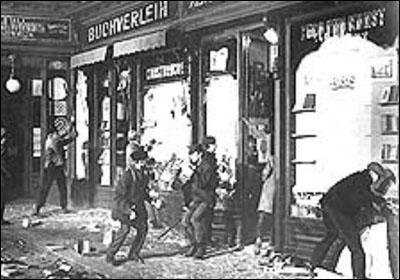
Paul Briscoe could hear the crowd chanting "Jews out! Jews out!" In his autobiography, My Friend the Enemy: An English Boy in Nazi Germany (2007) Briscoe recalled: "I didn't understand it. The shop was owned by Mira. Everybody in Miltenberg knew her. Mira wasn't a Jew, she was a person. She was Jewish, yes, but not like the Jews. They were dirty, subhuman, money-grubbing parasites - every schoolboy knew that - but Mira was - well, Mira: a little old woman who was polite and friendly if you spoke to her, but generally kept herself to herself. But the crowd didn't seem to know this: they must be outsiders. Nobody in Miltenberg could possibly have made such a mistake. I was frightened for her.... A crash rang out. Someone had put a brick through her shop window. The top half of the pane hung for a moment, like a jagged guillotine, then fell to the pavement below. The crowd roared its approval." (38)
Armin Hertz was 14 years old in 1938. His parents owned a furniture store in Berlin. He later explained what happened that night: "During the Kristallnacht, our store was destroyed, glass was broken, the synagogues were set on fire. There was a synagogue in the same street where we lived. It was on the first floor of a commercial building; downstairs were stores, and upstairs was a synagogue. In the back of that building, there was a factory so they could not set that synagogue on fire because people were living and working there. But they threw everything out of the window - the Torah scrolls, the prayer books, the benches, everything was lying in the street." (39)
On 11th November, 1938, eight-year-old Paul Briscoe was told by his teacher that the day's lessons had been cancelled and that they had to attend a meeting in Miltenberg: "Whatever was going to happen must have been planned well in advance, for the streets were lined with Brownshirts and Party officials, and the boys from the senior school were assembled in the uniform of the Hitler Youth. A festival atmosphere filled the town. Party flags, red, black and white, hung from first-floor windows, fluttering and snapping in the breeze - just as they did during the Führer's birthday celebrations each April. But there was something angry and threatening in the air, too."
The boys were then marched to the Miltenberg Synagogue. "We all stood there staring at it while we waited to find out what was to happen next. For a long moment, nobody moved and all was quiet. Then, another command was shouted - I was too far back to make out the words - and the boys at the front broke ranks, flying at the synagogue entrance, cheering as they ran. When they reached the door, they clambered over each other to beat on it with their fists. I don't know whether they broke the lock or found a key, but suddenly another cheer went up as the door opened and the big boys rushed in. We youngsters stood still and silent, not knowing what to expect."
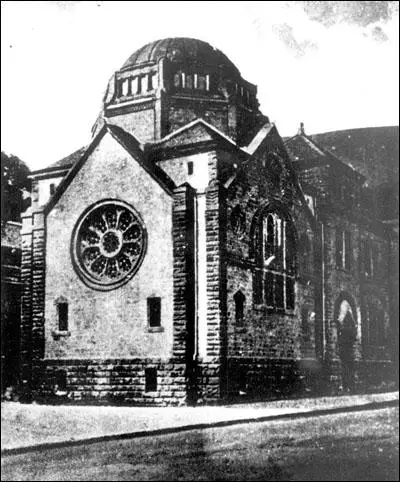
Herr Göpfert ordered Briscoe and the other young boys to go into the synagogue: "Inside was a scene of hysteria. Some of the seniors were on the balcony, tearing up books and throwing the pages in the air, where they drifted to the ground like leaves sinking through water. A group of them had got hold of a banister rail and kept rocking it back and forth until it broke. When it came away, they flung the spindles at the chandelier that hung over the centre of the room. Clusters of crystal fell to the floor. I stood there, transfixed by shock and disbelief. What they were doing was wrong: why weren't the adults telling them to stop? And then it happened. A book thrown from the balcony landed at my feet. Without thinking, I picked it up and hurled it back. I was no longer an outsider looking on. I joined in, abandoning myself completely to my excitement. We all did. When we had broken all the chairs and benches into pieces, we picked up the pieces and smashed them, too. We cheered as a tall boy kicked the bottom panel of a door to splinters; a moment later, he appeared wearing a shawl and carrying a scroll. He clambered up to the edge of the unbanistered balcony, and began to make howling noises in mockery of Jewish prayers. We added our howls to his."
Briscoe then described what happened next: "As our laughter subsided, we noticed that someone had come in through a side door and was watching us. It was the rabbi: a real, live Jew, just like the ones in our school textbooks. He was an old, small, weak-looking man with a long dark coat and black hat. His beard was black, too, but his face was white with terror. Every eye in the room turned to him. He opened his mouth to speak, but before the words came, the first thrown book had knocked his hat off. We drove him out through the main door where he had to run the gauntlet of the adults outside. Through the frame of the doorway I saw fists and sticks flailing down. It was like watching a film at the cinema, but being in the film at the same time. I caught close ups of several of the faces that made up the mob. They were the faces of men that I saw every Sunday, courteously lifting their hats to each other as they filed into church." (40)
The Miltenberg Synagogue interior was destroyed during Kristallnacht. "A section of the building was later demolished to create space for a parking lot, and the remainder was converted into a residential property. Forty-three Miltenberg Jews emigrated and 42 relocated within Germany. In 1942, the remaining ten Jews were deported to Izbica and to Theresienstadt. At least 39 Miltenberg Jews perished in the Shoah". (41)
Herbert Lutz admitted that after Kristallnacht he became aware that Jews were being sent to concentration camps: " We heard about a transport of people going out. There were rumors that people were killed, but there was never any mention of gas chambers. There were rumors that said people were squeezed together in these camps and most died of typhoid fever.... I didn't really give it any thought. I was fifteen, sixteen years old. We heard this on the periphery. That was not, to kids of my age at the time, our primary interest. We didn't think about it. No, we didn't even think about it. They were out of sight. I'm talking about people who are fifteen years old.... There weren't very many Jews, first of all. Even at the time when all the Jews were still in Cologne, you hardly ever saw any Jewish people where we lived in the Cologne suburbs of Sülz and Klettenberg." (42)
The Hitler Youth in the Classroom
By 1938 there were 8,000 full-time leaders of the Hitler Youth. There were also 720,000 part-time leaders, often schoolteachers, who had been trained in National Socialist principles. One teacher, who was hostile to Hitler, wrote to a friend: "In the schools it is not the teacher, but the pupils, who exercise authority. Party functionaries train their children to be spies and agent provocateurs. The youth organizations, particularly the Hitler Youth, have been accorded powers of control which enable every boy and girl to exercise authority backed up by threats. Children have been deliberately taken away from parents who refused to acknowledge their belief in National Socialism. The refusal of parents to 'allow their children to join the youth organization' is regarded as an adequate reason for taking the children away." (43)
Some parents refused to allow their children to join the Hitler Youth. Johannes Fest, a head teacher who lost his job over his unwillingness to support the government, refused to allow his son, Joachim Fest, to join. However, after he was sent to a boarding school in Freiburg. Their new head teacher, Dr. Hermann insisted that he took part in the activities. Joachim later admitted that he quite enjoyed the experience: "The bells rang out from Bernward's tower... and we listened reverently to the beating of a drum, a so-called Landsknechtstrommel which punctured not only the addresses given and the songs, but also the heroic passages of the war stories that were read out - we had to march around in a circle in the school playground in wind and rain, crawl on our stomachs, or hop over the terrain in a squatting position holding a spade or a branch in our out-stretched hand." He also was sent away to camp where he spent time on "mindless... military training drill." (44)
Teachers constantly feared the possibility that their Hitler Youth students would inform on them. Herbert Lutz went to a school in Cologne. "My favorite teacher was my math teacher. I remember that one day he asked me a question. I was wearing my uniform, and I stood up, clicked my heels, and he blew up." The teacher shouted: "I don't want you to do this. I want you to act like a human being. I don't want machines. You're not a robot." After the lesson he called Lutz into his office and apologized. Lutz later recalled: "He was probably afraid that I might report him to the Gestapo." (45)
For example, a 38-year-old teacher in Düsseldorf told a joke to her class of twelve-year-olds, that was slightly critical of Adolf Hitler. She immediately realised that she had made a mistake and pleaded with the children not to tell anybody about it. One of the children told his parents and they promptly informed the Gestapo. She immediately lost her job and sent to prison for three-weeks. (46)
Hildegard Koch was a member of the League of German Girls (BDM), the female branch of the Hitler Youth movement. She later recalled how the students controlled the curriculum: "As time went on more and more girls joined the BDM, which gave us a great advantage at school. The mistresses were mostly pretty old and stuffy. They wanted us to do scripture and, of course, we refused. Our leaders had told us that no one could be forced to listen to a lot of immoral stories about Jews, and so we made a row and behaved so badly during scripture classes that the teacher was glad in the end to let us out." (47)
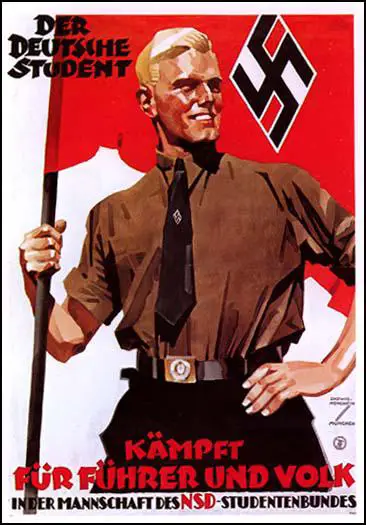
Erich Dressler played an active role in getting rid of teachers he considered to be opponents of the Nazi Party: "In 1934, when I had reached the age of ten, I was sent to the Paulsen Realgymnasium. This was still a regular old-fashioned place with masters in long beards who were completely out of sympathy with the new era. Again and again we noticed that they had little understanding for the Führer's maxim - the training of character comes before the training of intellect.They still expected us to know as much as the pupils used to under the Jewish Weimar Republic, and they pestered us with all sorts of Latin and Greek nonsense instead of teaching us things that might be useful later on. This brought about an absurd state of affairs in which we, the boys, had to instruct our masters. Already we were set aflame by the idea of the New Germany, and were resolved not to be influenced by their outdated ideas and theories, and flatly told our masters so. Of course they said nothing, because I think they were a bit afraid of us, but they didn't do anything about changing their methods of teaching."
It was decided to get rid of the Latin teacher. "Our Latin master set us an interminable extract from Caesar for translation. We just did not do it, and excused ourselves by saying that we had been on duty for the Hitler Youth during the afternoon. Once one of the old birds got up courage to say something in protest. This was immediately reported to our Group Leader who went off to see the headmaster and got the master dismissed. He was only sixteen, but as a leader in the Hider Youth he could not allow such obstructionism to hinder us in the performance of duties which were much more important than our school work.... Gradually the new ideas permeated the whole of our school. A few young masters arrived who understood us and who themselves were ardent national socialists. And they taught us subjects into which the national revolution had infused a new spirit. One of them took us for history; another for racial theory and sport. Previously we had been pestered with the old Romans and such like; but now we learned to see things with different eyes. I had never thought much about being well educated; but a German man must know something about the history of his own people so as to avoid repeating the mistakes made by former generations." (48)
Teachers encouraged members of the Hitler Youth to inform on their parents. For example, they set essays entitled "What does your family talk about at home?" According to one source: "Parents... were alarmed by the gradual brutalisation of manners, impoverishment of vocabulary and rejection of traditional values... Their children became strangers, contemptuous of monarchy or religion, and perpetually barking and shouting like pint-sized Prussian sergeant-majors." (49)
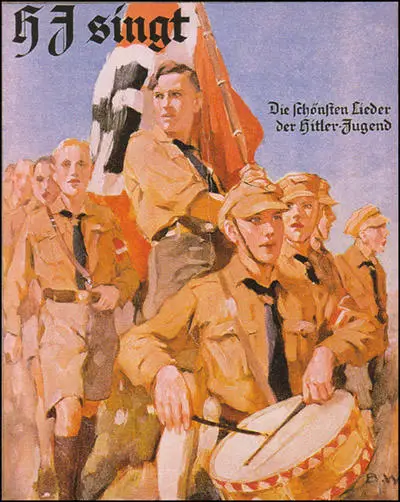
Tomi Ungerer, who went to school in Colmar, claims that his teachers encouraged his students to inform on his parents. "We were promised a reward of money if we denounced our parents or our neighbours - what they said or did... We were told: Even if you denounce your parents, and if you should love them, your real father is the Führer, and being his children you will be the chosen ones, the heroes of the future." (50)
According to one report the activities of the Hitler Youth and the Nazi government was slowly destroying the education system in Germany. "Everything that has been built up over a century of work by the teaching profession is no longer there in essence... They have been wilfully destroyed from above. No thought any more of proper working methods in school, or of the freedom of teaching. In their place we have cramming and beating schools, prescribed methods of learning and... learning materials. Instead of freedom of learning, we have the most narrow-minded school supervision and spying on teachers and pupils. No free speech is permitted for teachers and pupils, no inner, personal empathy. The whole thing has been taken over by the military spirit." (51)
The Second World War
By the end of 1938 the Hitler Youth numbered 7,728,259. Although this number is very high, it meant that over 4 million youths had avoided joining. In March 1939 the government issued a law conscripting all young people into the Hitler Youth on the same basis as they were drafted into the German Army. "Recalcitrant parents were warned that their children would be taken away from them and put into orphanagesor other homes unless they enrolled." (52)
An important aspect of the role of the Hitler Youth was military training. Erich Dressler later explained: "We used to carry out regular military exercises in the woods around Berlin, and we always thought this the high spot of our duties... War veterans from an SA detachment came along to direct our operations. We were given real strategic tasks, like the defence of a hill or a road crossing, and we soon learned how to read ordnance maps and work out compass directions." (53)
As Erwin Hammel pointed out: "Special youth groups were founded - for example, the Hitler Youth Flyers... Also there was the National Socialist Motor Vehicle Operators Corps (NSKK), which drove motor-cycles... I got into the Naval Hitler Youth, and that was basically more interesting to us because we could cruise the Rhine and didn't have to march along the streets and bellow songs and such things like the regular Hitler Youth." (54)
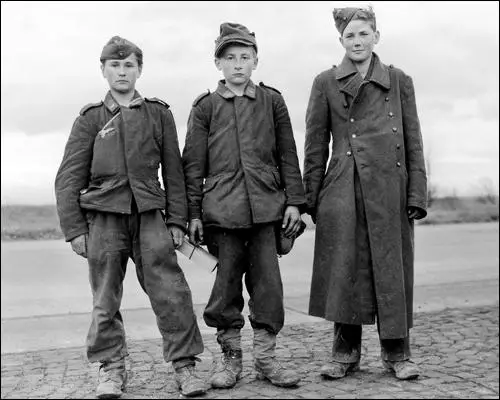
On the outbreak of the Second World War the Hitler Youth were given a role in air defence work. When the German Army began to run out of men, members of the Hitler Youth were encouraged to join the 12th SS Panzer Division that was commanded by the youngest of the German generals, Kurt Meyer. The division fought in France in 1944 and in Germany in 1945. (55)
However, some former Hitler Youth members turned against Hitler. For example, former members, Hans Scholl, Sophie Scholl, Christoph Probst, Alexander Schmorell and Willi Graf formed the White Rose resistance group. In February 1943, these students were executed for distributing anti-Nazi leaftlets. (56) It has been pointed out that between "1940 and 1945, 1,807 inmates were executed in the Brandenburg prison alone for political reasons.... Of these, 75 were under twenty years of age; 22 were high-school pupils or university students. In Hamburg between 1933 and 1945, of all those sentenced for political crimes, 11 per cent were youths." (57)
Desperately short of workers, the government used the Hitler Youth as cheap labour. In 1944 Paul Briscoe and his unit was sent to Breisgau-Hochschwarzwald, with the local German Girls' League (BDM) to help with the hop harvest. "We would stay there for a fortnight. We were to travel in uniform, taking a second set of clothes in which to work. We would work eight hours a day, Saturdays included. The BDM girls would join us in the fields when they were not cooking or washing. On Sundays we would be free to attend meetings, and then rest. Tools, baskets and stools would be provided.... We broke into song as the train pulled out. We felt like heroes and holidaymakers both at once. The journey took all day, because we took a cross-country route, collecting carriages of other youngsters at various stations... We had lots of fun that fortnight, but it wasn't quite the treat we had expected. The beer turned out to be Nahrbier with very little alcohol in it, and I worked so hard that I was too tired even to think about sex. If any of the other boys and girls managed to get up to anything like that, I didn't notice. The work was tough, but it was happy and purposeful." (58)
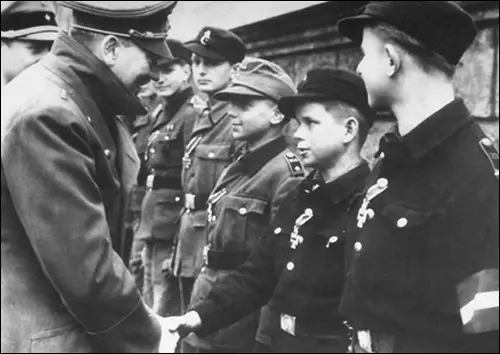
At the age of 18 Erich Dressler was able to join the German Army. However, by this time Germany were suffering defeat after defeat. He was wounded fighting in both Italy and the Soviet Union. He returned to Steglitz, on the outskirts of Berlin in the final weeks of the war. "When I reached our house in Steglitz, I found only a heap of rubble. The neighbours told me that my parents were still underneath. I got two men to help me and we started digging. After six days we found the unrecognisable shape of the body of an elderly woman. On the eighth day I found my father. I knew his clothes, and his spectacles were still grotesquely perched where his nose must have been.The woman may have been my mother. Anyway I buried them together in the corner of the park." (59)
In the final months of the war members of the Hitler Youth, some aged only 14 and 15, fought on the front-line against the advancing Allies. (60) Ilse Koehn, a schoolgirl in Berlin, remembers that on 3rd March, 1945,her teacher, Dr. Graefe, made an announcement: "Today your Fatherland has called the class of 1929... Those born in 1929 are called up to bear arms. Those whose names I will read will report for duty as flak helpers in the assembly hall tomorrow morning at nine: Breller, Choenbach, Gerhard, Mertens, Mons, Mueller, Schubach and Tetzlaff." Koehn commented that "his voice is toneless" and as he leaves the room he mumbles "insanity". However, she points out that the boys whose names had been called out, "are clearly overjoyed... they feel like men." (61)
In the last few weeks of the war General Helmuth Weidling commanded underage Hitler Youth soldiers in the defence of Berlin. The lives of these young boys were sacrificed in order to prolong Hitler's life for a few days. (62) The last photograph ever taken of the Führer shows him decorating twenty Hitler Youth soldiers in the garden just outside his bunker. All the boys were war orphans. (63)
Primary Sources
(1) In 1936 Baldur von Schirach wrote a poem about Adolf Hitler that members of the Hitler Youth had to memorize and recite.
That is the greatest thing about him,
That he is not only our leader and a great hero,
But himself, upright, firm and simple,
In him the roots of our world.
And his soul touches the stars
And yet he remains a man like you and me.
(2) Martha Dodd, My Years in Germany (1939)
Young girls from the age of ten onward were taken into organizations where they were taught only two things: to take care of their bodies so they could bear as many children as the state needed and to be loyal to National Socialism. Though the Nazis have been forced to recognize, through the lack of men, that not all women can get married. Huge marriage loans are floated every year whereby the contracting parties can borrow substantial sums from the government to be repaid slowly or to be cancelled entirely upon the birth of enough children. Birth control information is frowned on and practically forbidden.
Despite the fact that Hitler and the other Nazis are always ranting about "Volk ohne Raum" (a people without space) they command their men and women to have more children. Women have been deprived for all rights except that of childbirth and hard labour. They are not permitted to participate in political life - in fact Hitler's plans eventually include the deprivation of the vote; they are refused opportunities of education and self-expression; careers and professions are closed to them.
(3) Baldur von Schirach wrote a prayer that had to be said by members of the Hitler Youth before meals.
Führer, my Führer given me by God,
Protect and preserve my life for long.
You rescued Germany from its deepest need.
I thank you for my daily bread.
Stay for a long time with me, leave me not.
Führer, my Führer, my faith, my light
Hail my Führer.
(4) Herman Rauschning, Hitler Speaks (1939)
In my great educative work," said Hitler, " I am beginning with the young. We older ones are used up. Yes, we are old already. We are rotten to the marrow. We have no unrestrained instincts left. We are cowardly and sentimental. We are bearing the burden of a humiliating past, and have in our blood the dull recollection of serfdom and servility. But my magnificent youngsters! Are there finer ones anywhere in the world? Look at these young men and boys! What material! With them I can make a new world.
"My teaching is hard. Weakness has to be knocked out of them. In my Ordensburgen a youth will grow up before which the world will shrink back. A violently active dominating, intrepid, brutal youth - that is what I am after". Youth must be all those things. It must be indifferent to pain. There must be no weakness or tenderness in it. I want to see once more in its eyes the gleam of pride and independence of the beast of prey. Strong and handsome must my young men be. I will have them fully trained in all physical exercises. I intend to have an athletic youth - that is the first and the chief thing. In this way I shall eradicate the thousands of years of human domestication. Then I shall have in front of me the pure and noble natural material. With that I can create the new order.
"I will have no intellectual training. Knowledge is ruin to my young men. I would have them learn only what takes their fancy. But one thing they must learn - self-command! They shall learn to overcome the fear of death, under the severest tests. That is the intrepid and heroic stage of youth. Out of it comes the stage of the free man, the man who is the substance and essence of the world, the creative man, the god-man. In my Ordensburgen there will stand as a statue for worship the figure of the magnificent, self-ordaining god-man; it will prepare the young men for their coming period of ripe manhood."
(5) Hans Massaquoi was born in Germany in 1926. His mother was German but his father came from Africa. Studs Terkel interviewed Massaquoi about his experiences during Nazi Germany for his book, The Good War (1985)
There was a drive to enroll young kids into the Hitler Youth movement. I wanted to join, of course. My mother took me aside and said, "Look, Hans, you may not understand, but they don't want you." I couldn't understand. All my friends had these black shorts and brown shirts and a swastika and a little dagger which said Blood and Honor. I wanted it just like everybody else. I wanted to belong. These were my schoolmates.
In 1936, our class had a chance to go to Berlin to watch the Olympics. Not all Germans were sold on this Hitler nonsense. Jesse Owens was the undisputed hero of the German people. He was the darling of the 1936 Olympic games. With the exception of a small Nazi elite, they opened their hearts to this black man who ran his butt off. I was so proud, sitting there.
It's clear to me that had the Nazi leadership known of my existence, I would have ended in a gas oven or at Auschwitz. What saved me was there was no black population in Germany. There was no apparatus set up to catch blacks. The apparatus that was set up to apprehend Jews entailed questionnaires that were mailed to all German households. The question was: Jewish or non-Jewish? I could always, without perjuring myself, write: non-Jewish.
(6) Hitler Youth Poster issued in 1934.
The Hitler Youth asks you today: why are you standing on the sidelines? Surely we can assume you hold to our Führer, Adolf Hitler? But this can only be achieved by joining the Hitler Youth. So you are faced with a question of loyalty: are you for the Fiihrer, and therefore also for the Hitler Youth, or are you against? In which case state this on the attached form, to confirm it in writing. This is your last chance. Fulfil your duty as a young German. Heil Hitler!
(7) Catrine Clay, Trautmann's Journey: From Hitler Youth to FA Cup Legend (2010)
Bert Trautmann couldn't wait to join the Hitler Youth. His mother, better educated than his father, had her misgivings. Her bright boy, her special one, hardly bothered with school books these days. But begged by Bert and bombarded with Nazi propaganda, his parents scraped together the money it took to buy the uniform: short black trousers, khaki shirt, black necktie and leather toggle, plus a badge bearing the Hitler Youth insignia, a flash of lightning on a black background. Bert wore it with intense pride as he stood erect giving the Nazi salute before the swastika banner, hair shorn short back and sides, and spoke the oath: "In the presence of the blood banner, I swear to devote all my powers and my strength to the saviour of our Reich, Adolf Hitler. I am willing and ready to give up my life for him, so help me God." No one in the Hitler Youth movement seemed to think it strange for a young boy, keen on sport and other outdoor pursuits, to swear an oath to give up his life for the Führer, should the moment arrive.In 1932 membership of the Hitler Youth had been 107,950. In 1933, after the Nazis came to power, it rose swiftly to 2,300,000 out of a total of 7,529,000 German youth. By 1936 it had risen to 5,400,000 out of a total of 8,656,000. By 1939, at the outbreak of the Second World War, it had reached 8,700,000 out of a total of 8,870,000. Those young boys you see in newsreels with a trembling Hitler in the spring of 1945, just weeks before the end of the war, boys no more than fourteen years of age saluting their Führer with pride in the face of certain defeat, those are the final intake of the Hitler Youth, the last gasp of the dream of a Thousand Year German Reich.
The great leap in membership in 1936 did not happen by accident. In 1934 the party had already issued a proclamation, posted at every street corner... Hitler Youths stood by the posters handing out the forms. Schools were ordered to put up lists in every classroom noting which boys were members, and which weren't. Those who weren't on a list soon received a letter, enclosing the form. Both the father and the son had to sign.
In 1936 came the first Hitler Youth Order, marking the moment when the Nazi Party decided that enough was enough. From now on measures would be taken to force all German youths between the ages of ten to eighteen to join, because time was running out: war was imminent. If a youth or a parent resisted, they would be fined and given a warning, if they continued to resist, the father might find himself out of a job. After that it was to one of the concentration camps, which were springing up all over Germany, designed to contain anyone who opposed the party: communists, socialists, Jews or fathers who didn't want their sons joining the Hitler Youth.
(8) Herbert Lutz, interviewed by the authors of What We Knew: Terror, Mass Murder and Everyday Life in Nazi Germany (2005)
A twelve-mile march was considered a mere nothing for boys who are trained until they can make a march of fifty miles without other food than the concentrated ration they carry in their packs.... Later the doctor confided to me that often after one of these lengthy marches he had as many as thirty boys in hospital. Pale-faced little fellows sometimes made a march of thirty miles singing Nazi songs through the night, for their graduation ceremony.
Whenever you have kids at that age, around ten years, or twelve years and younger, you have to maintain discipline. The discipline in the Hitler Youth was maintained simply by having certain punishments. For instance, if you talked out of turn, you were punished by not being allowed to wear your scarf for three weeks. That was not for really severe crimes; it was for clowning around or whatever. The other punishment was a more severe punishment. Part of our uniform was a dagger. Can you imagine a ten-year-old carrying a dagger? It was an honor to be allowed to wear that. If you did something really nasty, you were not allowed to wear your scarf and your dagger and that meant that you were like an outcast. If something worse happened, they would send you home and you had to work it out with your parents. That worked really well.
(9) Bernhard Rust, National Socialist Germany and the Pursuit of Learning (1938)
There is, indeed, twofold evidence to show that something was wrong with education. In the first place, the high level of popular enlightenment had failed to protect the German people against the poisonous effects of Marxist teaching and other false doctrines. Large masses of people had fallen victims to them, whilst other sections - more especially those of higher education - had been unable to take up an effective stand against the spread of the poison. If they had, the events of 1918 and the succeeding period of national disintegration and deterioration would have been prevented.
The attainment of high intellectual standards will certainly continue to be urged upon the young people; but they will be taught at the same time that their achievements must be of benefit to the national community to which they belong. As a consequence of the demand thus clearly formulated by the Nuremberg Laws, Jewish teachers and Jewish pupils have had to quit German schools, and schools of their own have been provided by and for them as far as possible. In this way, the natural race instincts of German boys and girls are preserved; and the young people are made aware of their duty to maintain their racial purity and to bequeath it to succeeding generations. As the mere teaching of these principles is not enough, it is constantly supplemented, in the National Socialist State, by opportunities for what may be called "community life". By this term we mean school journeys, school camps, school "homes" in rural neighbourhoods, and similar applications of the corporate principle to the life of schools and scholars.
(10) Schoolteacher, letter to a friend (December, 1938)
In the schools it is not the teacher, but the pupils, who exercise authority. Party functionaries train their children to be spies and agent provocateurs. The youth organizations, particularly the Hitler Youth, have been accorded powers of control which enable every boy and girl to exercise authority backed up by threats. Children have been deliberately taken away from parents who refused to acknowledge their belief in National Socialism. The refusal of parents to "allow their children to join the youth organization" is regarded as an adequate reason for taking the children away.
(11) Isle McKee was a member of the German Girls' League, later recalled her experiences in her autobiography.
We were told from a very early age to prepare for motherhood, as the mother in the eyes of our beloved leader and the National Socialist Government was the most important person in the nation. We were Germany's hope in the future, and it was our duty to breed and rear the new generation of sons and daughter. These lessons soon bore fruit in the shape of quite a few illegitimate small sons and daughters for the Reich, brought forth by teenage members of the League of German Maidens. The girls felt they had done their duty and seemed remarkably unconcerned about the scandal.
(12) Jutta Rüdiger, head of the German Girls' League, was shocked when she heard a speech given by in 1939 Heinrich Himmler in 1939.
He said that in the war a lot of men would be killed and therefore the nation needed more children, and it wouldn't be such a bad idea if a man, in addition to his wife, had a girlfriend would bear his children. And I must say, all my leaders were sitting there with their hair standing on end.
(13) Statement issued by the German government on 3rd May, 1941.
The Hitlerjugend (HJ) come to you today with the question: why are you still outside the ranks of the HJ? We take it that you accept your Fuehrer, Adolf Hitler. But you can only do this if you also accept the HJ created by him. If you are for the Fuehrer, therefore for the HJ, then sign the enclosed application. If you are not willing to join the HJ, then write us that on the enclosed blank.
(14) Cate Haste, Nazi Women (2001)
For Nazis, the key to the future of the Thousand Year Reich was the allegiance of youth. Hitler professed particular concern for children. He made a point of being filmed with them - at the Berghof, where he played the role of "Uncle Adolf" to the offspring of other leaders, looking unusually at ease as he chatted to them and cuddled them on his knee. It is a chilling picture. With children - and dogs - Hitler appeared relaxed. Other, more formal, photo-opportunities show him surrounded by uniformed young girls and boys, laughing as they look up adoringly at him. It was another aspect of stage-management of the leader cult.The boys' Hitler Youth movement was set up in 1926 and the League of German Girls - the BDM (Bund Deutscher Madel) - established in 1932. As soon as the Nazis came to power, they set about eliminating all other rival youth organizations, just as they Nazified the rest of German life. Within a short time, the Catholic Youth organization was the only group left with a rival claim to young people's loyalty. All existing religious political and other youth groups were taken over, disbanded or banned. In one year the Hitler Youth movement, including girls, had climbed from a membership of 108,000 to more than three and a half million.
The leadership immediately set about organizing youth into a coherent body of loyal supporters. Under Baldur von Schirach, himself only twenty-five at the time, the organization was to net all young people from ages ten to eighteen to be schooled in Nazi ideology and trained to be the future valuable members of the Reich. From the start, the Nazis pitched their appeal as the party of youth, building a New Germany. The leadership was fairly young itself, compared with the elderly, whiskery leaders of the Weimar Republic. Hitler was only forty-three in 1933, and his associates were even younger - Heinrich Himmler was thirty-two, Joseph Goebbels thirty-five and Hermann Goring forty. Hitler intended to inspire youth with a mission, appealing to their idealism and hope.
(15) Erich Dressler, Nine Lives Under the Nazis (2011)
In 1934, when I had reached the age of ten, I was sent to the Paulsen Realgymnasium. This was still a regular old-fashioned place with masters in long beards who were completely out of sympathy with the new era. Again and again we noticed that they had little understanding for the Führer's maxim - the training of character comes before the training of intellect.They still expected us to know as much as the pupils used to under the Jewish Weimar Republic, and they pestered us with all sorts of Latin and Greek nonsense instead of teaching us things that might be useful later on.
This brought about an absurd state of affairs in which we, the boys, had to instruct our masters. Already we were set aflame by the idea of the New Germany, and were resolved not to be influenced by their outdated ideas and theories, and flatly told our masters so. Of course they said nothing, because I think they were a bit afraid of us, but they didn't do anything about changing their methods of teaching. We were thus forced to "defend" ourselves.
This was rather simple. Our Latin master set us an interminable extract from Caesar for translation.We just did not do it, and excused ourselves by saying that we had been on duty for the Hitler Youth during the afternoon. Once one of the old birds got up courage to say something in protest. This was immediately reported to our Group Leader who went off to see the headmaster and got the master dismissed. He was only sixteen, but as a leader in the Hider Youth he could not allow such obstructionism to hinder us in the performance of duties which were much more important than our school work. From that day onwards the question of homework was settled. Whenever we did not want to do it we were simply "on duty," and no one dared to say any more about it.
Gradually the new ideas permeated the whole of our school. A few young masters arrived who understood us and who themselves were ardent national socialists. And they taught us subjects into which the national revolution had infused a new spirit. One of them took us for history; another for racial theory and sport. Previously we had been pestered with the old Romans and such like; but now we learned to see things with different eyes. I had never thought much about being "well educated"; but a German man must know something about the history of his own people so as to avoid repeating the mistakes made by former generations.
Gradually, one after the other of the old masters was weeded out.The new masters who replaced them were young men loyal to the Führer. The new spirit had come to stay.We obeyed orders and we acknowledged the leadership principle, because we wanted to and because we liked it. Discipline is necessary, and young men must learn to obey.
(17) Annette Dumbach & Jud Newborn, Sophie Scholl and the White Rose (1986)
Between 1940 and 1945, 1,807 inmates were executed in the Brandenburg prison alone for political reasons, some after years of forced labour. Of these, 75 were under twenty years of age; 22 were high-school pupils or university students. In Hamburg between 1933 and 1945, of all those sentenced for political crimes, 11 per cent were youths.
Student Activities
Adolf Hitler's Early Life (Answer Commentary)
The Hitler Youth (Answer Commentary)
German League of Girls (Answer Commentary)
The Political Development of Sophie Scholl (Answer Commentary)
The White Rose Anti-Nazi Group (Answer Commentary)
Kristallnacht (Answer Commentary)
Heinrich Himmler and the SS (Answer Commentary)
Trade Unions in Nazi Germany (Answer Commentary)
Adolf Hitler v John Heartfield (Answer Commentary)
Hitler's Volkswagen (The People's Car) (Answer Commentary)
Women in Nazi Germany (Answer Commentary)
